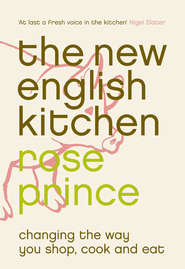По всем вопросам обращайтесь на: info@litportal.ru
(©) 2003-2024.
✖
The New English Table: 200 Recipes from the Queen of Thrifty, Inventive Cooking
Настройки чтения
Размер шрифта
Высота строк
Поля
Put the cauliflower in a shallow ovenproof dish and pour the sauce over the top. Either brown it under the grill or bake for a few minutes in an oven preheated to 240°C/475°F/Gas Mark 9, until browned on top.
Cauliflower leftovers
Crisped Cauliflower with Breadcrumbs and Garlic (#ulink_49989070-1b7d-51ff-9398-d0eb056323e3)
I like to fry previously boiled cauliflower with fresh breadcrumbs in a little oil, with a peeled garlic clove (to be removed later), then eat it with orecchiette, the little ‘ears’ of pasta that so effectively collect the broken, crisp pieces of cauliflower and crumbs. Grate some Parmesan cheese over the top.
Cauliflower Soup (#ulink_e6113da5-915a-5424-8694-7ffe978a881c)
Gently fry a chopped onion in butter or oil, then add the cooked cauliflower. Season with a little English mustard powder, cover with milk and stock (50/50) and bring to the boil. Liquidise and season, then serve hot with a little cream and chopped chives – or my favourite herb, chervil, if you can get it.
Glorious Rehash – A New Generation of Leftovers (#ulink_7ca44701-41b2-5297-bc6c-212224f2306d)
Thin, melting slices of rare roast beef, eaten with a mustard dressing tinted with anchovies and capers; cockles in a hotpot of seafood broth, served with a garlic sauce; little cauliflower florets crisped in a pan with breadcrumbs and olive oil; the lightest shrimp shell and straw mushroom broth, made warmer still with needles of fresh ginger; a radiant, creamy squash soup, flavoured with melted, brandy-washed cheese; or perhaps a dish of rice spiked with allspice and green pistachios, cooked in a pan with shards of roast lamb …
A menu that sounds richly indulgent but which is a good deed: in all these dishes there is something that might otherwise have been thrown away. Leftovers – the skeletons, shells, skins and extra flesh of foods deserving of a better future. Landfill that became a tummy full.
If you pay more for the best raw materials, it makes sense to use up every little bit. When a cut of well-hung meat from a slow-reared, grass-fed animal costs between twice and four times as much as one that was reared indoors and forced to grow fast on an unnatural diet, spreading the cost becomes an economic necessity. But this is not the only reason to reduce waste. It is estimated that one-third of the food bought in the UK is thrown away, ending up in landfill where it rots, emitting methane, a major contributing factor to climate change. The value of this food is estimated at £8 billion yearly – sympathy wanes, in certain cases, with complaints about paying more for better food.
The case for eating leftovers has not historically been helped by gloomy offerings of unidentifiable rissoles, khaki-hued ‘mystery’ vegetable soups, or bubble and squeak. An occasional plate of fried, leftover greens and mash is bearable but taken weekly it is tedious. There are other ways: using the colour and fragrance of fresh herbs from a pot on the windowsill, trying interesting seasonings, adding piquant dressings, wrapping with good bread or thin, olive oil pastry. Abandon bubble and squeak, take those cooked sprouts or spring greens, shred them and fry them instead in butter with cooked rice or whole grains of wheat; add ras al hanout, a Moroccan spice mix, then perhaps some chopped celery and shredded cold cooked chicken, game or lamb; sprinkle with black onion seeds once piping hot, then serve with creamy Greek yoghurt and fresh coriander. Suddenly you have in front of you a feast, even if one grown from humble beginnings. As for the spare cooked potato, mix it with a little potato flour and beaten egg, then make it into little patties; fry them and eat with smoked haddock, fresh peppery watercress and soured cream. Two typical leftover Sunday lunch foods become two extra, economical meals.
Broth, or stock, is the tea of bones. How can a nation that is self-confessedly addicted to tea not feel the same about stock made from chicken carcasses, beef shins, fish bones or prawn shells? Like tea, stock warms the soul and revives flagging energy levels. It is impossible not to feel good after eating food made with stock. It is even time-economic: once in the pan, it bubbles along unassisted, ready to use in an hour, or to bottle and freeze. A risotto or soup made with real stock has reserves of natural, heavenly flavour that underpin the goodness in the other ingredients and cut the need for salt. Doctors should prescribe stock – and go some way to preventing heart trouble. Casting pearls before swine may seem all too easy, but eat the pig from the tips of its toes to the end of its ears and there will be money for gems.
CELERY (#ulink_06910ff6-8893-5845-bc70-23abc894bf28)
Green Celery, Crayfish and Potato Salad (#ulink_749e5373-09ef-56ba-a2d5-815e184008b8)
Celery Soup (#ulink_000ace8b-43f0-5d85-9d18-511a8678771c)
Celery Stock (#litres_trial_promo)
Farmers and shops are dismissive of celery – you only have to watch the harvest to witness this, which I did one horrible wet day in Cambridgeshire. It is a magnificent-looking crop, tall and leafy, its big strong heart and root deep in the Fens. But as it is pulled out of the ground, the pickers immediately cut off all or most of the heart, then lop all but a few leaves from the top, leaving just 30cm/12 inches of stalk. I have a nasty suspicion that this execution, which is not practised in southern Europe where celery is sold in its gorgeous entirety, is carried out in order that the celery head will fit in the average carrier bag. It is true that no one is quite sure what to do with celery, except use it as a base for stews or stick it in a jug and put it out with the cheeseboard.
It’s nice to emerge from a market with a mane of foliage flying out behind you, and tap into a vegetable that has a flavour I can only describe as important. Celery is as much a seasoning as a main ingredient. Even the leaves, where the flavour is at its most intense, are useful and should not be wasted.
Buying celery
The original ‘Fenland’ celery is still grown in deep furrows in the Fens, and is available from October to December in Waitrose. You can use ordinary celery in any of the following recipes, but look out for heads with leaves.
Green Celery, Crayfish and Potato Salad (#ulink_d5801f87-d0b5-58a3-8d6b-158461f27032)
Jane Grigson’s salad of mussels, potatoes and celery inspired this rare, crayfish-packed version, which I made on my return from the Fens clutching a whole celery plant saved from the picker’s knife. I fancied that freshwater crayfish roam the streams around the fields where the celery and potatoes grow, circling them. So, as it does with other things that share a landscape, like pork and apples, it seemed right that they ended up in the same bowl. The result is a fresh and unusual salad, the sweetness of the crayfish pitched against the sharp, savoury celery, with the potato in between, mopping up the dressing.
For information on buying crayfish (#litres_trial_promo).
Serves 4 as a main course
600g/1lb 5oz new potatoes
280g/10oz celery sticks
200g/7oz shelled, cooked crayfish
4 tablespoons extra virgin olive oil
juice of 1 lemon
leaves from 2 sprigs of flat-leaf parsley
sea salt and freshly ground black pepper
Put the potatoes in a pan of water and bring to the boil. Cook until the point of a knife will slip in with just a little resistance. Remove from the heat, drain and immediately rinse with cold water to prevent further cooking. Allow to cool, then cut into slices 5mm/¼ inch thick. Put in a large bowl.
Pull any tough strings from the celery sticks and wash off any dirt. Slice them thinly across the grain, then rinse and pat dry.
Add the celery and crayfish to the bowl of potatoes and toss together with the oil, lemon juice, parsley, some freshly ground black pepper and a pinch of salt flakes. Use celery leaves for decoration.
Celery Soup (#ulink_1d49aec9-9554-5469-8449-8050619ae720)
Celery has awkward bits – namely the strings that run up the length of the stalks. Removing some of them will make this a smoother, creamier soup. Using a mixture of stock and milk gives it a more velvety texture still. The important part is the stewing of the vegetables in butter or oil at the beginning, because it helps to extract the maximum flavour.
Serves 6
½ head of celery, with leaves
85g/3oz butter or 4 tablespoons olive oil
2 white onions, chopped
4 medium potatoes, peeled and cut into dice
Вы ознакомились с фрагментом книги.
Приобретайте полный текст книги у нашего партнера:
Приобретайте полный текст книги у нашего партнера:









